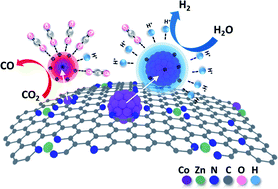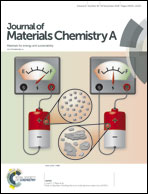Activity and selectivity regulation through varying the size of cobalt active sites in photocatalytic CO2 reduction†
Abstract
The development of efficient and economical catalysts for photocatalytic reduction of CO2 into chemical feedstocks is highly desirable for addressing both the global energy crisis and carbon emission problem. Herein, a series of carbonized cobalt composites derived from bimetallic Zn/Co zeolitic imidazolate frameworks (C-BMZIFs) are synthesized and used as the co-catalysts for [Ru(bpy)3]2+ mediated photocatalytic CO2 reduction under visible light irradiation. Varying the Zn/Co ratio allows regulation of the size of Co active sites, which further differentiates their catalytic activity towards CO2 reduction and H2 evolution, resulting in tunable CO/H2 ratio in the produced syngas. Among all investigated configurations, the C-BMZIF with a Zn/Co ratio of 3 : 1 demonstrates the highest CO yield of 1.1 × 104 μmol g−1 h−1, owing to the optimal balance between the quantity of active sites and the activity of each individual site. Consequently, this work provides insight into the design of stable MOF-derived co-catalysts for efficient photo-reduction of CO2, and offers an alternative solution for photocatalytic syngas production with tunable CO/H2 ratio.



 Please wait while we load your content...
Please wait while we load your content...